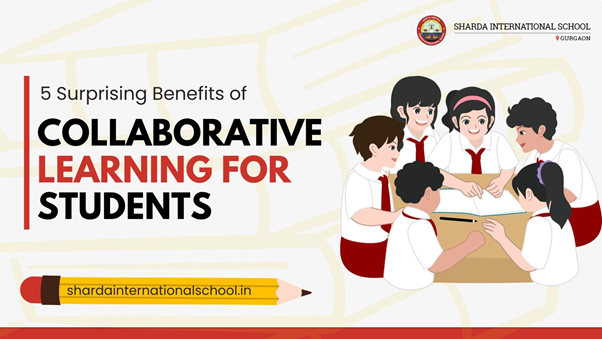5 Surprising Benefits of Collaborative Learning for Students

Did you know that the way students learn today has changed more than ever before? Gone are the days when they had
to sit quietly and copy notes from the board. Now, they ask questions. They share ideas. They
talk. They learn together. That’s where collaborative learning for students comes in—and it’s
not just a fancy classroom buzzword. It’s a real game-changer.
But wait, what exactly is collaborative learning? Simply put, it means learning in a group. Students work
as a team. They help one another. They solve problems side by side. And yes, it works wonders. Not just
in academics but in life too. Let’s dig a little deeper and uncover five surprising ways collaborative
learning for students is changing the game.
Advantages Of Collaborative Learning For Students
1. It Builds Confidence Without the Pressure
Not every student is confident. Some kids are shy. Some think they’re not smart enough. Some just freeze when the
teacher asks a question. But when they work in a group, things shift. They get support from their peers. They
hear different ideas. They speak up, even if it's just a little.
This kind of setup takes the pressure off. It feels less scary. A student who never raised their hand before might
suddenly share a thought or answer a question. And that’s how it begins. Step by step, their
confidence grows. Over time, they believe in themselves more. And that, honestly, is a win
in any book.
2. It Encourages Better Problem Solving
Life throws curveballs. Whether it’s a tough math problem or a disagreement with a friend, you need
problem-solving skills. And that’s exactly what collaborative learning for students teaches.
When kids sit together and try to crack a puzzle or complete a project, they learn to listen. They
think. They disagree. They compromise. They try again. This process isn’t just about finishing the
task. It’s about learning how to think critically and make better decisions.
And here’s the fun part—students often come up with unique solutions you’d never expect. That’s
the magic of different minds working together. It sparks creativity and opens up fresh ways of
thinking.
3. It Teaches Real Communication Skills
You know what never goes out of style? Good communication. And it’s not just about speaking well. It’s about
listening. It’s about knowing when to jump in and when to stay quiet. Collaborative learning for students
creates the perfect stage for this.
While working in groups, they have to explain their ideas. They have to listen to others. They have
to respond with respect. Sometimes, they even have to settle small conflicts. All this builds the
actual world communication skills—something even adults struggle with sometimes.
Over time, students start to express themselves clearly. They become better listeners. They understand
tone. They learn how to give feedback kindly. These are skills they’ll use for a lifetime.
4. It Boosts Engagement and Motivation
Classrooms can get boring. Especially when students feel like it’s just them against the textbook. But something
amazing happens when learning becomes a team sport.
Students get more involved. They laugh. They challenge each other. They stay curious. That’s because
collaborative learning for students makes learning more active. It’s not just about watching or
listening. It’s about doing. About sharing. About building something together.
And when kids feel like they matter in a group, they try harder. They feel proud when their ideas help someone else.
That small spark of motivation can make all the difference in how they perform in school and how they feel about
themselves.
5. It Prepares Them for the Real World
No matter what job you do one day—doctor, designer, entrepreneur, anything—you’ll need to work with people. And
that’s exactly what collaborative learning for students prepares them for.
They learn how to work in a team. They learn patience. They handle different personalities. They
figure out how to deal with people who may not always agree with them. In short, they learn people
skills that no textbook can teach.
Even in fields that seem solo, like writing or coding, teamwork shows up. Whether it’s group projects, team meetings
or simply bouncing ideas off someone, collaboration is everywhere. So why not start learning it early?
Why It Truly Matters?
Here’s the truth. The world is changing fast. We don’t just need students who score well. We need thinkers. Listeners.
Leaders. Helpers. That’s what collaborative learning for students brings to the table.
And the best part? It works for all kinds of learners. Whether they’re fast, slow, quiet or bold—everyone
has a place in a collaborative setup. Everyone gets a chance to shine.
So if you’re a parent wondering how to support your child’s learning or a teacher trying to make
lessons more fun, think about it. Maybe, just maybe, group work is the key to unlocking something
bigger.
A Final Thought
If you're a parent searching for more than just good grades and textbooks, you're not alone. Today’s children need
more than academic excellence—they need emotional strength, real-world skills and the confidence to speak up and
stand tall. And that’s exactly what collaborative learning for students nurtures every single day.
It’s not just about finishing projects in groups. It’s about building empathy, learning how to lead,
and understanding how to work with others who may think differently. It’s about celebrating each
small idea, each new perspective, and each moment of growth together.
So if you're wondering where your child can learn in an environment that supports teamwork, curiosity, and overall
growth, choosing the right school is the first step. One of the
Best CBSE schools in Gurgaon,
Sharda International
School, is recognized for its commitment to collaborative learning. Here, students are not only encouraged to
learn—they're encouraged to grow, together.